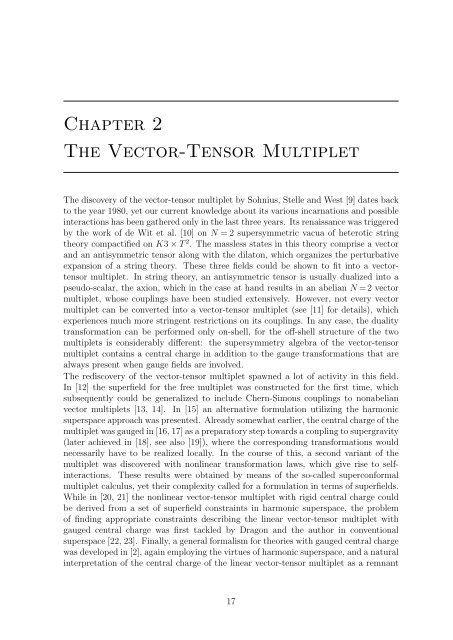N=2 Supersymmetric Gauge Theories with Nonpolynomial Interactions
N=2 Supersymmetric Gauge Theories with Nonpolynomial Interactions
N=2 Supersymmetric Gauge Theories with Nonpolynomial Interactions
You also want an ePaper? Increase the reach of your titles
YUMPU automatically turns print PDFs into web optimized ePapers that Google loves.
Chapter 2<br />
The Vector-Tensor Multiplet<br />
The discovery of the vector-tensor multiplet by Sohnius, Stelle and West [9] dates back<br />
to the year 1980, yet our current knowledge about its various incarnations and possible<br />
interactions has been gathered only in the last three years. Its renaissance was triggered<br />
by the work of de Wit et al. [10] on N = 2 supersymmetric vacua of heterotic string<br />
theory compactified on K3 × T 2 . The massless states in this theory comprise a vector<br />
and an antisymmetric tensor along <strong>with</strong> the dilaton, which organizes the perturbative<br />
expansion of a string theory. These three fields could be shown to fit into a vectortensor<br />
multiplet. In string theory, an antisymmetric tensor is usually dualized into a<br />
pseudo-scalar, the axion, which in the case at hand results in an abelian N = 2 vector<br />
multiplet, whose couplings have been studied extensively. However, not every vector<br />
multiplet can be converted into a vector-tensor multiplet (see [11] for details), which<br />
experiences much more stringent restrictions on its couplings. In any case, the duality<br />
transformation can be performed only on-shell, for the off-shell structure of the two<br />
multiplets is considerably different: the supersymmetry algebra of the vector-tensor<br />
multiplet contains a central charge in addition to the gauge transformations that are<br />
always present when gauge fields are involved.<br />
The rediscovery of the vector-tensor multiplet spawned a lot of activity in this field.<br />
In [12] the superfield for the free multiplet was constructed for the first time, which<br />
subsequently could be generalized to include Chern-Simons couplings to nonabelian<br />
vector multiplets [13, 14]. In [15] an alternative formulation utilizing the harmonic<br />
superspace approach was presented. Already somewhat earlier, the central charge of the<br />
multiplet was gauged in [16, 17] as a preparatory step towards a coupling to supergravity<br />
(later achieved in [18], see also [19]), where the corresponding transformations would<br />
necessarily have to be realized locally. In the course of this, a second variant of the<br />
multiplet was discovered <strong>with</strong> nonlinear transformation laws, which give rise to selfinteractions.<br />
These results were obtained by means of the so-called superconformal<br />
multiplet calculus, yet their complexity called for a formulation in terms of superfields.<br />
While in [20, 21] the nonlinear vector-tensor multiplet <strong>with</strong> rigid central charge could<br />
be derived from a set of superfield constraints in harmonic superspace, the problem<br />
of finding appropriate constraints describing the linear vector-tensor multiplet <strong>with</strong><br />
gauged central charge was first tackled by Dragon and the author in conventional<br />
superspace [22, 23]. Finally, a general formalism for theories <strong>with</strong> gauged central charge<br />
was developed in [2], again employing the virtues of harmonic superspace, and a natural<br />
interpretation of the central charge of the linear vector-tensor multiplet as a remnant<br />
17

















